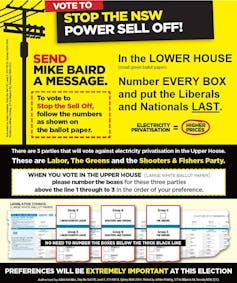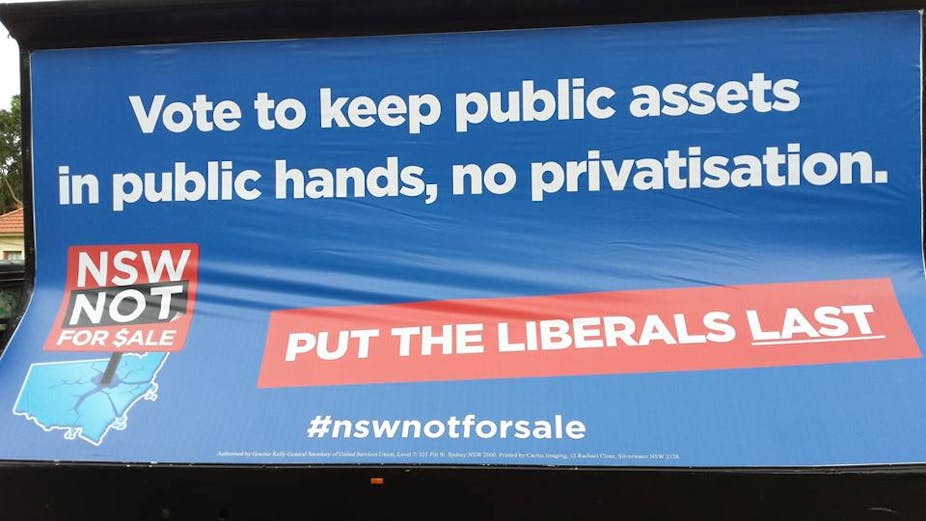At the New South Wales Liberal Party’s official launch on March 23, Premier Mike Baird urged voters to “just vote one” for his government, while warning against Labor’s “sneaky preference deals” with minor parties.
In contrast, Baird’s opponents are urging NSW voters to exercise their choice to number all the boxes on the lower house ballots, and “put the Liberals and Nationals last”.
Both the key issues and the messages about how to vote in this NSW election have striking parallels with those that dominated January’s Queensland election. In part, that’s because the Labor and union anti-privatisation campaign against the Baird government in NSW was first honed in Queensland.
But it’s also because NSW and Queensland have the same optional preferential voting system, unlike other states. The way Queenslanders chose to exercise their preferences was crucial in the shock defeat of that state’s Liberal National government.
Could that happen again in NSW?
Vote 1, number a few boxes, or number them all
NSW and Queensland are the only Australian states using optional preferential voting to elect their lower house MPs.

In a close election, the optional preferential voting system can not only affect the result, but also make it harder than in a federal election to use pre-election opinion polls to gauge what the two-party preferred vote will be.
Under optional preferential voting, a voter can indicate a preference for just one candidate, for two, three or more, or fill in every box, as I explained in greater detail in this article in The Conversation. (Meanwhile, Adrian Beaumont’s NSW election preview covers how to preference correctly in the upper house.)
In Queensland, the Newman government ran a strong “just vote 1” campaign, repeatedly claiming that votes for minor parties were “wasted votes”.
That is incorrect, as under optional preferential voting a vote can be cast first for a minor party with subsequent preferences allocated to other candidates the voter supports – thus giving the voter the right to choose only candidates they support. Electoral educators, other parties and interest groups criticised that “wasted votes” claim.
In fact, the Newman government feared that exhausted votes for minor parties would give the ALP an advantage – and that proved to be the case. (A vote is “exhausted” when it is removed from the count because the candidates preferenced on the ballot have been eliminated from the count. You can read a more detailed explanation here.)
At this year’s election, ABC election analyst Antony Green says Queensland saw a 20% decline in exhausted preferences, and a similar size increase in preference flows to Labor. Many of those preferences went to the ALP, helping it to form a minority government.
Green has concluded that the well-organised Labor and union campaign to “put the LNP last” was crucial in Queensland election result:
It looks like those preferences recommendations, and the decisions of voters themselves to number more squares, have been the difference between Labor winning the 2015 election and the LNP being returned … Preferences can still make a difference.
Vote 1 for privatisation, or preference against it?
In the Queensland election, the LNP government staked its re-election strategy on an infrastructure program funded by privatising assets, despite the political backlash against its Labor predecessor’s plans for assets sales.
In the month before the election, most opinion polls showed that the Newman government was set to suffer a big swing, but still likely to hang on.
In NSW, the polls are not as close as they were in Queensland. And in contrast to Campbell Newman, Mike Baird’s high personal popularity is seen as one of the government’s strongest selling points.
But Baird has still been similarly “courageous” – as they used to say on Yes, Minister – by declaring “there is no Plan B” to fund many of his campaign promises without the government’s plan for partial privatisation of the power industry.
Most polls and the ABC’s Vote Compass have shown the majority of NSW voters oppose privatisation.
However, the latest Fairfax/Ipsos poll shows there is less opposition when people are asked for their view on privatisation with the proceeds being used for infrastructure, with a result of 48% in support and 47% opposed.
Nevertheless, privatisation has given new Labor leader Luke Foley a central theme to run with, which does seem to have resonated in many parts of the state, especially in regional areas and with women.
So just as in Queensland, the only question now is: come election day on March 28, will voters heed the “just vote 1” message, or will preferences prove crucial in deciding the next NSW government?
Read more of The Conversation’s coverage of the 2015 NSW election.

